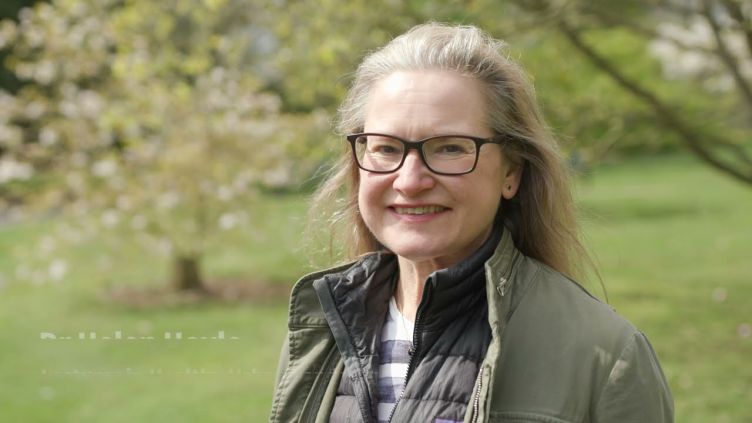Dr Helen Hoyle
School of Architecture and Landscape
Lecturer in Healthy Urban Landscapes


Full contact details
School of Architecture and Landscape
Arts Tower
Western Bank
Sheffield
S10 2TN
- Profile
-
I have expertise in research at the intersection of nature and human wellbeing, informing policy and practice to prioritise human wellbeing, biodiversity and sustainability in the context of a changing climate. I aim to identify synergies and tensions between these priorities in planning, designing, and managing urban green infrastructure for diverse stakeholders and communities. I believe passionately in the need to work closely with policy makers, practitioners, and communities, the people juggling these priorities on the ground in real places.
My research investigates the role of aesthetics and colour in human reactions to green infrastructure. I first worked on designing the meadows for the London 2012 Olympic Park, then went onto apply these ideas in ordinary green spaces in Bedfordshire. From 2012-17, I worked as a research associate on the Urban BESS Project (Fragments, functions and flows – the scaling of biodiversity and ecosystem services in urban ecosystems funded by grant NE/J015369/1 from the Biodiversity and Ecosystem Service Sustainability (BESS) programme. One output from this work includes a publication focusing on local authority stakeholder perceptions of the opportunities and challenges of introducing perennial urban meadows. I’m now working closely with Luton Parks Service and a local primary school to create an arboretum-meadow which will provide an educational resource and foster nature-connection amongst children.
I relish working closely with diverse stakeholders in large multisector teams. Working in these roles I aim to facilitate communication between the multidisciplinary academic teams and practitioners, managing their often-contrasting expectations and priorities.
- Qualifications
-
- Post Graduate Certificate in Academic Practice (PCAP) University of the West of England.
- PhD: Human happiness v urban biodiversity? Public perception of designed urban planting in a warming climate. Department of Landscape, University of Sheffield with Professor James Hitchmough and Dr Anna Jorgensen.
- MA Landscape Architecture (Distinction) University of Sheffield.
- BA Geography Oxford University (St Edmund Hall)
- Research interests
-
- Aesthetics, colour and human reactions to urban green infrastructure (UGI)
- Futureproofing places for climate resilience, biodiversity and human health and wellbeing
- Co-creating nature-based solutions (NBS) in deprived diverse places
- Connecting children with nature through co-creating NBS
- Green social prescribing: Opportunities, challenges, and environmental co-benefits
I use integrative inter-disciplinary approaches drawn from environmental psychology, urban ecology, sociology and cultural geography. As a landscape architect I believe strongly in the importance of design for diverse urban publics rather than for professional elites, and aim to reconcile human aesthetic preferences, well-being and ecological objectives.
Current projects include:
The QUENCH network: A network linking the Quality of Urban Environments with Nature Connectedness and Health
The 'Futureproofing Luton' project: Co-producing an educational air quality arboretum-meadow on a disused mini-golf site in a diverse, deprived area with partners including a local primary school, and the Landscape Institute. Initially funded by a public engagement award from UWE Bristol, this project is significant in its aspiration to contribute to greater environmental equity and to foster nature-connectedness amongst local children.
Physical activity in different natural environments: A collaboration with parkrun UK, Stevenage parkrun, Barking parkrun and Fell foot parkrun to investigate the perceived wellbeing benefits of physical activity in different natural environments for diverse socio-cultural groups.
- Publications
-
Journal articles
- ‘I'm a better version of me!’ Increasing health equity through active green interventions: parkrun participants' motivators, preferences and well-being benefits. People and Nature. View this article in WRRO


- Pollinator‐promoting interventions in European urban habitats—a synthesis. Ecology Letters, 28(8). View this article in WRRO


- Moving from features to functions: bridging disciplinary understandings of urban environments to support healthy people and ecosystems. Health & Place, 90. View this article in WRRO


- ‘The Elephant in the Room’ – does actual or perceived biodiversity elicit restorative responses in a virtual park?. Cities & Health. View this article in WRRO


- Does increasing biodiversity in an urban woodland setting promote positive emotional responses in humans? A stress recovery experiment using 360-degree videos of an urban woodland. PLOS ONE, 19(2). View this article in WRRO


- Beyond the ‘usual suspects’? Engaging children in diverse communities in co-producing an arboretum-meadow: professional partner perspectives. Urban Forestry and Urban Greening, 81.


- Perceptions of colour, form and amenity in green spaces.. Urban Design Journal, 162, 28-30. View this article in WRRO


- Climate-adapted, traditional or cottage-garden planting? Public perceptions, values and socio-cultural drivers in a designed garden setting. Urban Forestry & Urban Greening, 65.


- Rethinking ‘future nature’ through a transatlantic research collaboration: climate-adapted urban green infrastructure for human wellbeing and biodiversity. Landscape Research, 48(4), 460-476. View this article in WRRO


- Urban meadows as an alternative to short mown grassland : effects of composition and height on biodiversity. Ecological Applications, 29(6). View this article in WRRO


- What determines how we see nature? Perceptions of naturalness in designed urban green spaces. People and Nature, 1(2), 167-180. View this article in WRRO


- Plant species or flower colour diversity? Identifying the drivers of public and invertebrate response to designed annual meadows. Landscape and Urban Planning, 180, 103-113. View this article in WRRO


- Perceived species-richness in urban green spaces: Cues, accuracy and well-being impacts. Landscape and Urban Planning, 172, 1-10. View this article in WRRO


- Attractive, climate-adapted and sustainable? Public perception of non-native planting in the designed urban landscape. Landscape and Urban Planning, 164, 49-63. View this article in WRRO


- All about the ‘wow factor’? The relationships between aesthetics, restorative effect and perceived biodiversity in designed urban planting. Landscape and Urban Planning, 164, 109-123. View this article in WRRO


- “Not in their front yard” The opportunities and challenges of introducing perennial urban meadows: A local authority stakeholder perspective. Urban Forestry and Urban Greening, 25, 139-149. View this article in WRRO


- Biodiverse perennial meadows have aesthetic value and increase residents’ perceptions of site quality in urban green-space. Landscape and Urban Planning, 158, 105-118. View this article in WRRO


Book chapters
- People and naturalistic vegetation: the social and cultural dimensions of design, The Dynamic Landscape (pp. 76-101). Routledge


- What is urban nature and how do we perceive it? In Dempsey N & Dobson J (Ed.), Naturally challenged: contested perceptions and practices in urban green spaces (pp. 9-36). Springer Cham View this article in WRRO


Conference proceedings
- Beyond the ‘wow factor’? Climate resilient green infrastructure for people and wildlife. Proceedings of the Fábos Conference on Landscape and Greenway Planning, Vol. 7(1) (pp 37-37). Budapest, Hungary, 30 June 2022 - 30 June 2022. View this article in WRRO


Reports
- Improving urban grassland for people and wildlife: access to nature is beneficial to human health. How can designed urban meadows help to enhance public well-being and urban biodiversity? View this article in WRRO


Theses
- ‘I'm a better version of me!’ Increasing health equity through active green interventions: parkrun participants' motivators, preferences and well-being benefits. People and Nature. View this article in WRRO
- Research group
- Teaching activities
-
LSC 336 Landscape Planning Toolkits
LSC 6005 Special Project
LSC 6008 Maintaining Green Infrastructure
- Professional activities and memberships
-
Landscape Institute Accreditation Sub Committee
Associate Editor Landscape Research
Associate Editor People and Nature
Athena Swan lead for Landscape Architecture

